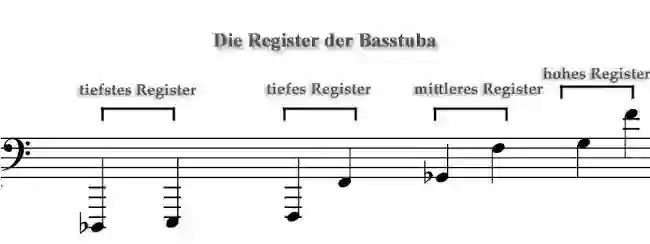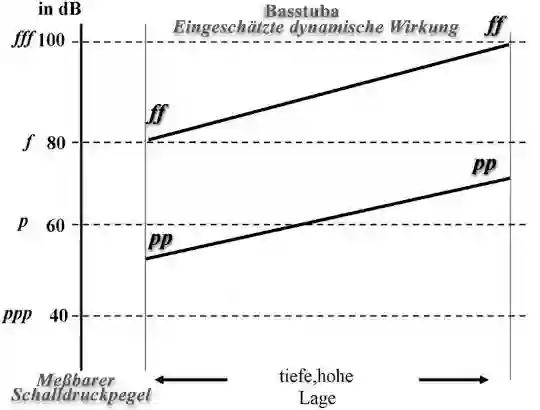Sound character of the Bass tuba - Philipp Dangas
Register table of the bass tuba
There is a fundamental sound difference between the cylindrical and the cup mouthpiece instruments (tubas). The sound of the slim-bore, cylindrical cup-mouthpiece instruments is sharply contoured, particularly when the instrument is blown in with high overtones and is therefore metallic and luminous.
The conical tubular scale of the bugle horns prevents the formation of higher natural tones, both in the practice technique and in the sound. All bugle horns blown with a cup mouthpiece have a sustainable but lackluster tone. The contrabass tuba and the bass tuba are an exception - but under very specific conditions. The large tube size of the instruments particularly favors the development of the deep tones of the bass register, so that the sound acquires a special fullness, warmth and softness. The prerequisite is that the tone is under no circumstances forced.
As part of the „symphonic world music“
The bass tuba is responsible for the execution of the funtamental bass in the orchestra and should not be regarded as a means of making noise. The sound of the tuba when it is not forced, i.e. in pianissimo [pp] piano [p] and mezzoforte [mz], is of extraordinary richness, softness and warmth and at the same time a continuation of the horn sound towards the depths.
[Music composer: Dmitri Shostakovich]
Download size: 173 kilobytes
Table summary of the sound character of the bass tuba
This table lists of the bass tuba the registers and timbres briefly and concisely described. The high register becomes the middle register and the low register and the deepest register described.
Dynamic effect of the bass tuba
Sheet music for the dynamic table of the bass tubaClearly recognizable is in the dynamic table the specification of the degrees of strength of musical dynamics. In addition to the sound pressure scale measured in decibels [dB], the degrees of strength of musical dynamics are given on the left, which can be understood as "objective" degrees.
The decibel scale is shown in a graph. It shows the estimated dynamic effect over the entire tonal range of the instrument. The dynamic effect (volume) as judged (perceived) by the listener.
Now an example: In the low register of the trumpet the dynamic range is between pianissimo [pp] 46 decibels [dB] and fortissimo [ff] 82 decibels [dB] = 36 decibels [dB]. In the high register, the range is 8 decibels [dB]. The estimated values can deviate more or less from the "objective" ones.
As a result, the deviations from instrument to instrument are fundamentally different. The mentioned "objective" levels of intensity piano pianissimo [ppp]= 40 decibels [dB], p=60 decibels [dB] etc. enable the composer to predict the dynamic effects of different instruments that are sounding simultaneously.
Table summary of bass tuba dynamic range
The following table shows the achievable dynamic range of the bass tuba shown. The span is the difference between the fortissimo and the Pianissimo in the same pitch.

A large representation of the register table of a bass tuba
- high register
- With each dynamic forcing towards the top, becoming more and more resonant and dry
- middle register
- In piano [p] horn-like and in pianissimo [pp],
in mezzoforte [mz] dull-sounding and coarse - low register
- Velvety, warm, noble and gloomy sound
- lowest register
- Only for instruments with good tone response and very wide bores.

The dynamic table of the Bass tuba
Internal search function
| Name | Value | Delete |
|---|